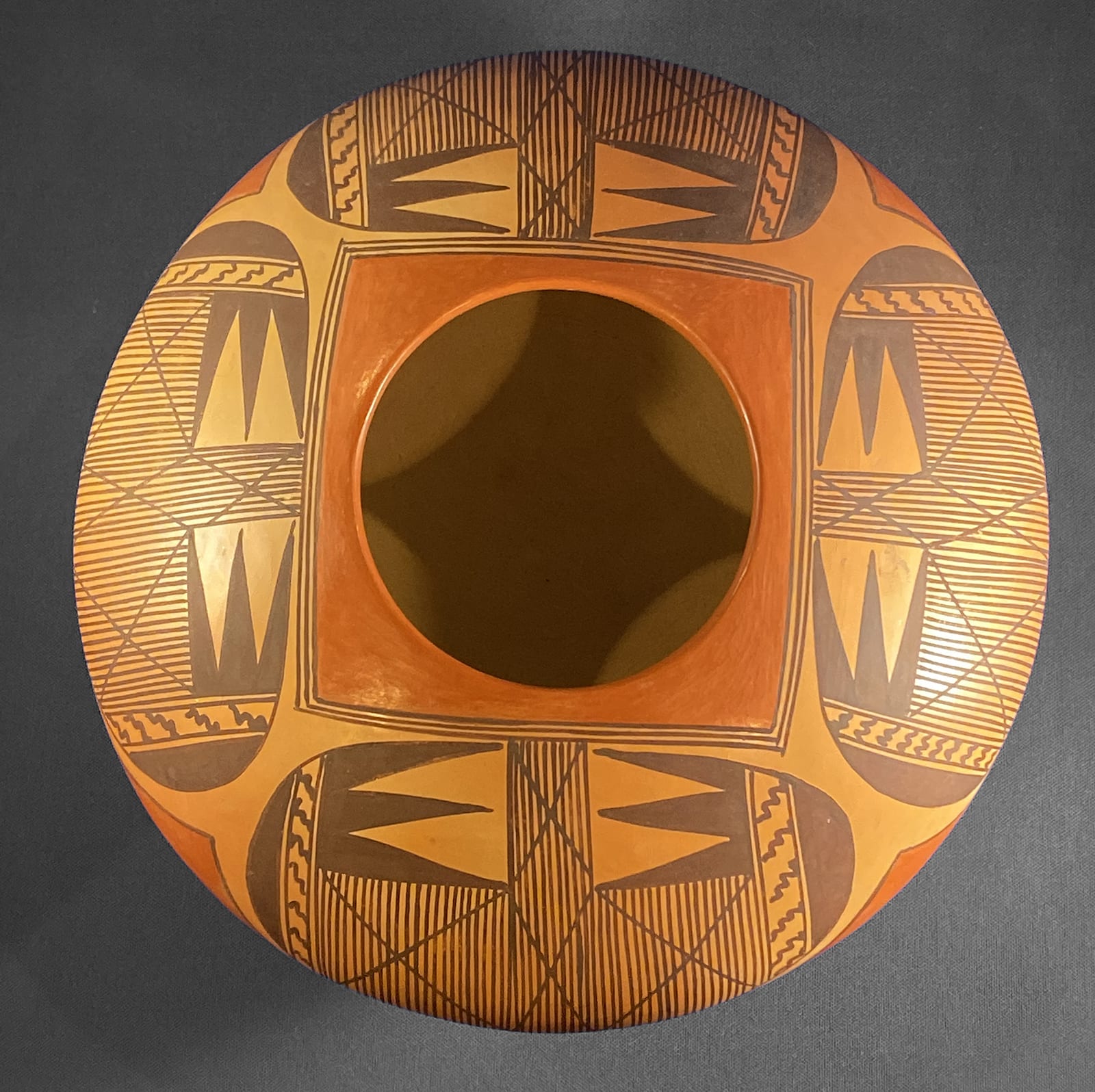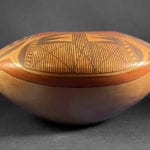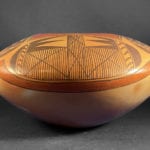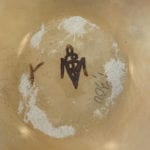This is a conceptually simple pot with a powerful, elegant presence. This collection has a number of pots with this “batwing” design (see Category list), but often the design seems casual, routine and does not intrigue my eye.
An exception is the batwing jar by Lowell Cheresposy (2011-24) and now this seedpot by Jean Shamie. Jean is Dextra’s niece; Lowell is Dextra’s grandson. Unusual for Hopi, both potters incorporated some micaceous clay in the body of their batwing pots and the resulting glimmer can be seen on both the inside and outside of their jars. The bottom half of jar 2019-17 is left undecorated, but because of the flecks of mica and the variations in color from its firing, it has a subtle (almost subliminal) vibrancy. The use of micaceous clay is not a Hopi or Hopi-Tewa tradition, but was inspired by the use of such clay by potters of the northern Rio Grande pueblos (Anderson, 1999). Dextra and her students introduced the technique to Hopi. The coincidence of micaceous clay and elegant batwing designs by these potters might be simply chance, but it may also suggest some intentional coordination of time or place by these two relatives.
The walls of this vessel are surprising thin and thus the pot is light-weight. Frequently the tops of seedjars (from the waist to the opening) are thinner than the pot below the waist so that the wet top coils do not collapse as they slope laterally toward the lip. That is not the case here: both the bowl below the waist of 2019-17 and the top slope are thin and of similar thickness, attesting to Jean’s skill.
The pot was fired outdoors.
Pot 2019-17 was an item catalogued for a live auction, its description including the statement “Overall good condition with scattered minor scuffs and nicks commensurate with age. Scattered minor inherent firing cracks including a .5″-long crack to rim.” However, no such scuffs, nicks or cracks are seen on pot 2019-17. The pot is in pristine condition.
The pot came with a Polaroid photograph of Jean with her grandson Keanu (“Kai”) Zacarius and two pots, one this batwing jar.. Kai was born in 2000 and appears to be about one-year-old in the photograph, which would date jar 2019-17 as being made about 2001.
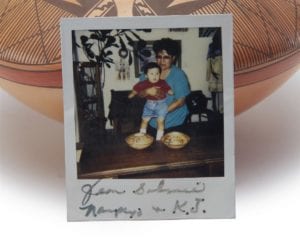
The opening of the jar is surrounded by a red square, its points positioned between the four oval batwings below. The square is surrounded by three thin black framing lines, forming a two-lane “highway.” This square red form around the opening of a seedpot is a common pattern used by Hopi/Tewa potters. The four large black oval designs are about 3″ deep and 5.25″ wide. Underneath is a red framing line, itself framed by thin black lines. This red element is an inventive addition to the usual batwing design. It curves to conform to the bear-paw ovals and rises between these ovals to form a point that reflects the pointed corners of the red square above.
The descriptor “batwing” is an invention of Anglo traders and collectors and, as far as I know, carries no meaning in Hopi or Tewa culture. Still, it is how this design is commonly referenced as so this terminology will be used here. Each batwing is pendant on a 1.0″ stem from the outer black line framing the central red square. The design is symmetrical, with the right lobe reflective of the left. The far edge of the lobes are a solid black quarter moon, its straight edge followed by two parallel lines forming a single-lane “highway.” About 0.25″ towards the center of the design is another single-lane highway. (This distance varies between renditions.) Between these two parallel elements are a series of wavy elements like upside down “Ws.” Of the eight renditions, the number of these wavy lines varies from 5 to 10 per strip, with a median of 6. Filling the upper third of the ovals between the wavy element and the pendant stem are three solid black pointed elements, the so-called “bear claws.”
The rectangular pendant and central lower two-thirds of the design are filled with a series of vertical parallel lines, varying from 19 to 25 among the four oval renditions. Jean then drew slanted lines that crossed the parallel lines to form a series of “Xs.” A narrow X fills the pendant rectangle with a similar narrow X below it. On either side of the lower narrow X are wider Xs that fills the remaining space. Collectively these bisecting lines fill the lower-central portion of the oval with a series of triangles that overlay the grid of parallel lines.
This layout of the batwing is a standard form, but the skill with which Jean painted the design creates an unusual sense of centered serenity. She drew about 90 parallel lines to form the four oval designs. While these lines vary in thickness and are not exactly parallel, they touch only six times. Moreover the design incorporates contradictory tensions that are controled because the black central design is contained between the two red elements of design.The red square pulls the eye to the pot’s opening, as do the tips of the bear paws. Within the oval forms the pendant crosshatching hangs down. The points of the lower red framing line pull the eye up to the points of the red square, which point down. The four oval forms orbit evenly around the jar. These contrary tendencies energize the design while the balanced elements and skilled painting lend a sense of serenity.
In 2014 Jean was named an “Arizona Living Treasure.” This pot is a vote for that distinction.

